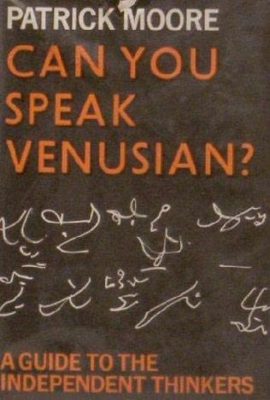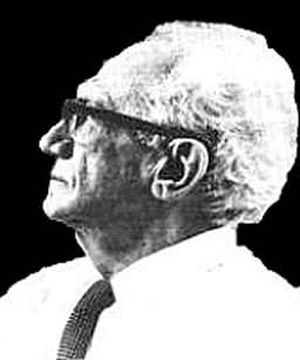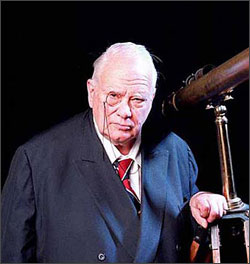Sir Alfred Patrick Caldwell-Moore, CBE, HonFRS, FRAS (b. 4 March 1923 Pinner, d. 9 December 2012) was an English amateur astronomer and broadcaster, who has been a critic of Velikovsky. Moore devotes a chapter to Velikovsky in his book, “Can You Speak Venusian?: A Guide to the Independent Thinkers” (1972)[1]Patrick Moore, Can you speak Venusian? A guide to independent thinkers, Publisher: David & Charles, Newton Abbot, ISBN: 9780715356913 Moore briefly mentions Velikovsky in several of his other books, going back to 1954.[2]Patrick Moore, Guide to Comets, Published by James Clarke & Co., 1977, ISBN 071882315X, 9780718823153, 111 pages[3]Patrick Moore, Venus, Published by Cassell Illustrated, 2005, ISBN 1844034046, 9781844034048, 191 pages[4]Patrick Moore, Our Universe: An Introduction, Published by AAPPL, 2007, ISBN 1904332412, 9781904332411, 128 pages
Moore on Velikovsky
Immanuel Velikovsky is first mentioned by Moore in his 1954 book, Suns, myths, and men (1954)[5]Patrick Moore, Suns, myths, and men, Publ. F. Muller, 1954, 192 pages, page 143 In other books, Moore describes:
“Another theory is bound up with a book by a Russian writer, Dr. Immanuel Velikovsky, who believes that Venus bounced about the Solar System rather in the manner of a celestial table-tennis ball, periodically approaching the Earth…”[6]Patrick Moore, The story of man and the stars, publ. Norton, 1955, 246 pages, p. 181
“.. (Venus’) Ashen Light has been put down to atomic bombs exploding on the surface of Venus. Still, even this is a sensible theory compared with those of Dr. Immanuel Velikovsky, of Russia, who seriously thinks that Venus is an ancient comet…”[7]Patrick Moore, The worlds around us, publ. Abelard-Schuman, 1956, 157 pages, p.99
“Since 1950 there have appeared several books by an eccentric psychiatrist, Dr Immanuel Velikovsky, who confuses planets with comets, and believes Venus to have been a comet only a few thousands of years ago!”[8]Patrick Moore, The Guinness book of astronomy facts & feats, publ. Guinness Superlatives, 1979, ISBN 0900424761, ISBN 9780900424762, 288 pages, p. 123
“Equally remarkable is Dr. Immanuel Velikovsky, who is convinced that Venus began its career as a comet and was ejected from Jupiter – after which it bounced around the Solar System in the manner of a cosmical ping-pong ball…”[9]Patrick Moore, The next fifty years in space, publ. Taplinger Pub. Co., 1978, ISBN 0800855299, ISBN 9780800855291, 144 pages, p.66

In his book, Guide to comets (1977), Moore writes:[10]Patrick Moore, Guide to comets, publ. James Clarke & Co., 1977, ISBN 071882315X, ISBN 9780718823153, 111 pages, pp.26
“Since the 1950s books have flowed from the pen of a psychiatrist, Dr. Immanuel Velikovsky, who was born in Russia, trained in Israel and has spent much of his life in America. Velikovsky’s first offering, entitled Worlds in Collision, was in some respects similar to Whiston’s inasmuch as it confused planets with comets. It was widely publicized, and started a curious cult which still persists.
“To Velikovsky, the time-scale of the universe is measured in thousands of years rather than in millions. He explains how the giant planet Jupiter suffered a tremendous outburst, and shot out a comet which later became the planet Venus. In 2500 B.C. the comet Venus bypassed the Earth; this was the time of the Israelite Exodus led by Moses, and the Earth’s rotation was slowed down, drying up the Red Sea at a convenient moment for the Israelites to cross. Tremendous upheavals followed; petrol rained down, so that our modern fuel represents ‘remnants of the intruding star which poured forth fire and sticky vapour’. Two months later, after the Earth had started spinning again, the comet Venus returned for a second visit, producing the thunder and lightning noted at the time of the sermon on Mount Sinai. Other encounters followed, one of which caused the tremors which shook down the walls of Jericho, but then the comet collided with Mars and lost its tail, so turning into the modern planet Venus. Meanwhile Mars itself moved closer to the Earth, and almost hit us in 687 B.C. … Velikovsky gives instance after instance, all ‘supported’ by quotations from the Bible which are, incidentally, quite correct!
“Nobody with even the most elementary knowledge of science can take this rigmarole seriously, but at least Velikovsky’s theories are harmless, and the world would be poorer without the never-ending supply of what I have termed ‘Independent Thinkers’..”
And in his book, Our Universe: An Introduction, Moore writes:[11]Patrick Moore, Our Universe: An Introduction, publ. AAPPL, 2007, ISBN 1904332412, ISBN 9781904332411, 128 pages, p.101
“I must also mention Dr. Immanuel Velikovsky, author of a book called World in Collision (1950). Velikovsky was a psychiatrist, so it is not surprising that his astronomical views were rather unusual. He believed that planets could change into comets, and vice versa (!) and that at one stage Venus, either as a comet or a planet, bounced around the Solar System in the manner of a cosmic table-tennis ball, periodically encountering the Earth and causing events such as the Biblical Flood. He became quite a cult figure.”
Criticisms
Velikovsky on Moore
In a letter to Lynn Rose, Velikovsky comments that Patrick Moore has described him as a “King of Fools”, noting that his British publisher:
“Sidgwick & Jackson are proud to announce the new volume in Velikovsky’s series “Ages in Chaos.” On a later page, Patrick Moore is modestly displayed for his “1978 Yearbook of Astronomy”, and has to take this pecking order, he being the author of “Do you speak Venusian?”, presenting me as a King of Fools.”[12]Letter, “Immanuel Velikovsky to Lynn Rose“, May 11, 1977 at the Velikovsky Archive
From Brian Moore
SIS co-founder, Brian Moore writes:
“Coming to Velikovsky’s predictions, Moore himself is entirely predictable, his basic position being that “anyone who makes enough forecasts will be bound to make some correct statements eventually”. The list of Velikovsky’s incorrect predictions reminds me irresistibly of Senator McCarthy’s list of communists in the State Department: it is perpetually referred to but never materialises. Moore duly fails to produce such a list, but makes two specific points: (a) on the claim of hydrocarbons in the atmosphere of Venus he states that the evidence shows “a total lack of anything of the sort” and (b) on the claim that argon and neon are substantial components of the Martian atmosphere – “it has turned out to be almost pure Carbon Dioxide”. As to the former, (a typical gross misrepresentation of the present inconclusive evidence) we will defer further comment until the findings of the latest Russian Venera probe are published. On the latter the new evidence of the Mars 6 spaceprobe supports Velikovsky’s claim, not Moore’s.
“Finally, Patrick Moore provides a fine example of the disingenuousness so prevalent amongst Velikovsky’s critics. In order to explain away Velikovsky’s prediction of a “hot” Venus, Moore informs us that “since Venus is, on average, 26 million miles closer to the sun than we are, and has a dense atmosphere which acts in the manner of a greenhouse, this perhaps was a safe prediction”. Writing in 1961 (11 years after “Worlds in Collision” appeared), Moore was not so percipient. In “Astronomy” (Oldbourne Press, 1961) he failed to make this deduction and stated: “… the dust desert idea still has its supporters, more likely however is the suggestion by Whipple and Menzel that the clouds consist of H2O and that Venus is largely covered with water.”[13]Brian Moore, “Sages in Chaos”, SIS Review Vol 1 No 2 (Spring 1976), page 18.
References
| ↑1 | Patrick Moore, Can you speak Venusian? A guide to independent thinkers, Publisher: David & Charles, Newton Abbot, ISBN: 9780715356913 |
|---|---|
| ↑2 | Patrick Moore, Guide to Comets, Published by James Clarke & Co., 1977, ISBN 071882315X, 9780718823153, 111 pages |
| ↑3 | Patrick Moore, Venus, Published by Cassell Illustrated, 2005, ISBN 1844034046, 9781844034048, 191 pages |
| ↑4 | Patrick Moore, Our Universe: An Introduction, Published by AAPPL, 2007, ISBN 1904332412, 9781904332411, 128 pages |
| ↑5 | Patrick Moore, Suns, myths, and men, Publ. F. Muller, 1954, 192 pages, page 143 |
| ↑6 | Patrick Moore, The story of man and the stars, publ. Norton, 1955, 246 pages, p. 181 |
| ↑7 | Patrick Moore, The worlds around us, publ. Abelard-Schuman, 1956, 157 pages, p.99 |
| ↑8 | Patrick Moore, The Guinness book of astronomy facts & feats, publ. Guinness Superlatives, 1979, ISBN 0900424761, ISBN 9780900424762, 288 pages, p. 123 |
| ↑9 | Patrick Moore, The next fifty years in space, publ. Taplinger Pub. Co., 1978, ISBN 0800855299, ISBN 9780800855291, 144 pages, p.66 |
| ↑10 | Patrick Moore, Guide to comets, publ. James Clarke & Co., 1977, ISBN 071882315X, ISBN 9780718823153, 111 pages, pp.26 |
| ↑11 | Patrick Moore, Our Universe: An Introduction, publ. AAPPL, 2007, ISBN 1904332412, ISBN 9781904332411, 128 pages, p.101 |
| ↑12 | Letter, “Immanuel Velikovsky to Lynn Rose“, May 11, 1977 at the Velikovsky Archive |
| ↑13 | Brian Moore, “Sages in Chaos”, SIS Review Vol 1 No 2 (Spring 1976), page 18. |

